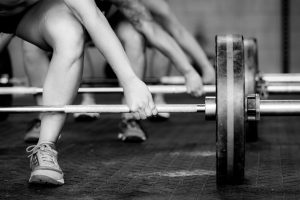If you’ve ever seen an athlete shake their limbs before a big lift or event, chances are you’ve taken notice of the ritual. Some say shaking it out relieves nerves and muscle tightness, making your body ready for what you’re about to do.
In this article, we’ll address the question: How effective is “shaking it out”?
The G-tox Technique
Unfortunately, there is very little research surrounding the effects of shaking it out prior to performing in functional fitness.
Specifically in reference to rock climbing, the G-tox Technique is often used. This technique is used to help the arms recover, making use of gravity to detoxify the arms and accelerate recovery.
How does it work?
Some believe the raised-arm position is best for recovery, while others are partial to the dangling-arm position. The G-tox technique alternates both arm positions, which allows good blood to flow in and old blood to flow out.
Start with the dangling position (arms at your sides), and give it a gentle shake or wiggle for 5 seconds. Then, raise your arm to a half-best position above your shoulder and give it a gentle shake or wiggle for 5 seconds. This cycle is repeated as often as needed.
Sore Muscles
Despite what kind of exercise you practice, most athletes experience sore limbs at one time or another. This is caused by lactic-acid build-up and restriction of blood flow. Lactic acid and its effects can stop the flow of blood into the capillaries, and give you the horrible burning sensation in your muscles during a tough workout.
Placing your arms in the dangling position helps blood flow into your forearms, however, it does not help the “old blood” flow out because of its position below the heart. Staying in this position alone would only slow down recovery.
Raising your arm above your heart helps the “old blood” flow out quickly. This position allows faster removal of lactic acid and in turn, has faster recovery in grip strength. Grip strength is important for any sport and in the things we do every day—like catching, throwing and grabbing. However, staying in the raised-arm position for a longer period would only require muscle contraction in the upper torso, which could cause fatigue and possible limitation in performance.
The G-tox method was tested in 2005 by a British researcher named Luke Roberts. He measured the blood lactate and grip strength of climbers using the G-tox method versus climbers using the standard declining-arm shakeout. The results of this research showed that the climbers who applied the G-tox method had a significant increase in grip strength.
How does this work in Functional Fitness?
Roberts’ study shows how the G-tox method is effective for the upper arms, however, it doesn’t give us a definite answer on its effectiveness for the lower body. We can’t raise our legs above the heart to rest—especially in rock climbing. You may not be able to apply this technique while doing an AMRAP, but if you want to see improvement in your grip strength, there is no harm in giving it a try.
Many athletes and trainers believe shaking it out—arms and legs—is effective in relieving nerves and muscle tightness. What’s your experience in shaking it out?


















